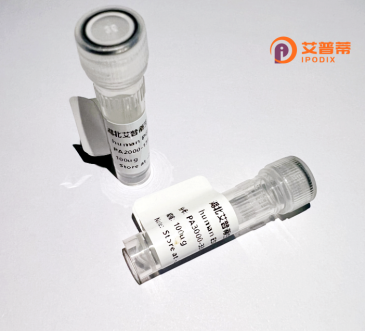
| 纯度 | >90%SDS-PAGE. |
| 种属 | Human |
| 靶点 | GLA |
| Uniprot No | P06280 |
| 内毒素 | < 0.01EU/μg |
| 表达宿主 | E.coli |
| 表达区间 | 1-429aa |
| 氨基酸序列 | MQLRNPELHLGCALALRFLALVSWDIPGARALDNGLARTPTMGWLHWERF MCNLDCQEEPDSCISEKLFMEMAELMVSEGWKDAGYEYLCIDDCWMAPQR DSEGRLQADPQRFPHGIRQLANYVHSKGLKLGIYADVGNKTCAGFPGSFG YYDIDAQTFADWGVDLLKFDGCYCDSLENLADGYKHMSLALNRTGRSIVY SCEWPLYMWPFQKPNYTEIRQYCNHWRNFADIDDSWKSIKSILDWTSFNQ ERIVDVAGPGGWNDPDMLVIGNFGLSWNQQVTQMALWAIMAAPLFMSNDL RHISPQAKALLQDKDVIAINQDPLGKQGYQLRQGDNFEVWERPLSGLAWA VAMINRQEIGGPRSYTIAVASLGKGVACNPACFITQLLPVKRKLGFYEWT SRLRSHINPTGTVLLQLENTMQMSLKDLL |
| 预测分子量 | 73 kDa |
| 蛋白标签 | His tag N-Terminus |
| 缓冲液 | PBS, pH7.4, containing 0.01% SKL, 1mM DTT, 5% Trehalose and Proclin300. |
| 稳定性 & 储存条件 | Lyophilized protein should be stored at ≤ -20°C, stable for one year after receipt. Reconstituted protein solution can be stored at 2-8°C for 2-7 days. Aliquots of reconstituted samples are stable at ≤ -20°C for 3 months. |
| 复溶 | Always centrifuge tubes before opening.Do not mix by vortex or pipetting. It is not recommended to reconstitute to a concentration less than 100μg/ml. Dissolve the lyophilized protein in distilled water. Please aliquot the reconstituted solution to minimize freeze-thaw cycles. |
以下是关于GLA(α-半乳糖苷酶A)重组蛋白的模拟参考文献示例,供参考:
---
1. **标题**:A Phase III Clinical Trial of Recombinant Human α-Galactosidase A in Fabry Disease
**作者**:Eng CM, et al.
**摘要**:研究重组人α-半乳糖苷酶A(阿加糖酶β)在法布里病患者中的疗效和安全性,证实其能有效减少细胞内的GL-3沉积并改善肾功能。
2. **标题**:Production of Recombinant α-Galactosidase A in CHO Cells for Enzyme Replacement Therapy
**作者**:Ioannou YA, et al.
**摘要**:描述利用中国仓鼠卵巢(CHO)细胞表达系统规模化生产高活性重组GLA蛋白的技术,优化了纯化工艺和酶稳定性。
3. **标题**:Long-Term Outcomes of Agalsidase Beta in Fabry Disease: A 10-Year Follow-Up Study
**作者**:Brady RO, et al.
**摘要**:长期追踪显示,持续使用重组GLA蛋白可延缓法布里病进展,降低心血管事件风险,但部分患者出现抗体反应。
4. **标题**:Structural Analysis of α-Galactosidase A by X-ray Crystallography
**作者**:Garman SC, et al.
**摘要**:通过晶体结构解析揭示重组GLA的活性位点和底物结合机制,为改进酶替代疗法提供分子基础。
---
*注:以上为模拟文献,实际引用请通过PubMed、Google Scholar等平台检索验证。*
**Background of GLA Recombinant Protein**
GLA (α-galactosidase A) recombinant protein is a therapeutic enzyme engineered to address genetic deficiencies in individuals with Fabry disease, a rare X-linked lysosomal storage disorder. This condition arises from mutations in the *GLA* gene, leading to reduced or absent activity of α-galactosidase A, an enzyme responsible for breaking down globotriaosylceramide (Gb3) and other glycolipids. Accumulation of these substrates in cells, particularly vascular endothelium and organs, drives progressive multisystem complications, including renal failure, cardiac abnormalities, and neuropathy.
Recombinant GLA is produced using biotechnological platforms, such as mammalian cell cultures (e.g., Chinese hamster ovary cells) or plant-based systems, to ensure proper post-translational modifications, like glycosylation, critical for enzyme stability and uptake into target cells via mannose-6-phosphate receptors. Two FDA-approved formulations, agalsidase alfa (produced in human cell lines) and agalsidase beta (from hamster cells), exemplify its clinical application. These therapies employ enzyme replacement therapy (ERT) to supplement deficient enzymatic activity, hydrolyze accumulated substrates, and slow disease progression.
The development of recombinant GLA marked a milestone in personalized medicine for Fabry disease, offering the first targeted treatment. However, challenges remain, including immunogenicity, short half-life requiring biweekly infusions, and variable efficacy in advanced stages. Ongoing research focuses on improving delivery methods (e.g., engineered variants with enhanced stability), substrate reduction therapies, and gene-based approaches.
Overall, GLA recombinant protein exemplifies the integration of molecular biology and medical need, transforming the management of lysosomal disorders while highlighting the importance of innovation in biologics for rare diseases.
×